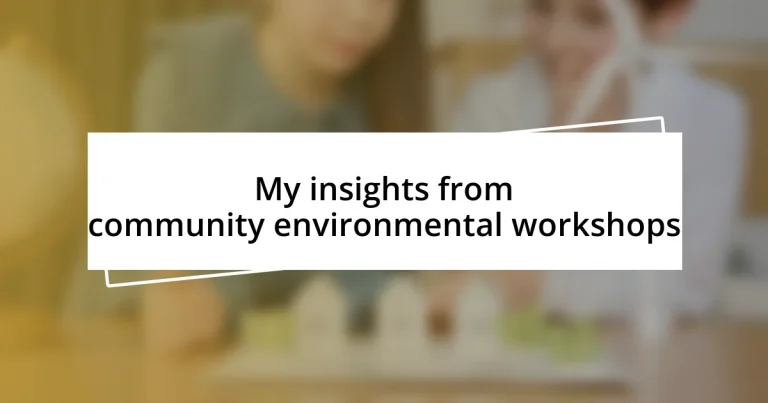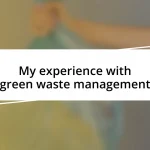Key takeaways:
- Community environmental workshops foster a sense of community, empowering individuals and encouraging collective action towards sustainability.
- Effective engagement strategies, such as storytelling and interactive activities, enhance participation and create emotional connections among attendees.
- Measuring the impact of workshops through feedback and tracking community initiatives demonstrates tangible changes and reinforces the importance of continued involvement.

Understanding community environmental workshops
Community environmental workshops are transformative gatherings where participants can learn about sustainability and ecological challenges specific to their area. I remember attending one such workshop that opened my eyes to the pollution issues affecting our local river. Hearing stories from community members added a personal touch, making me realize how interconnected we all are in this fight for a healthier environment.
These workshops serve as a platform for sharing knowledge and fostering dialogue. During a session focused on waste reduction, a participant shared her struggle with single-use plastics, which resonated with me deeply. Have you ever considered how your daily habits impact the environment? Engaging in these conversations helped me rethink my choices and inspired me to adopt more sustainable practices.
What stands out to me is the sense of community that forms in these workshops. I recall leaving one feeling incredibly motivated, surrounded by like-minded individuals who truly cared about making a difference. Isn’t it empowering to be part of a collective effort aimed at nurturing our planet? Each workshop creates a safe space for expressing concerns, sharing ideas, and igniting passion for environmental stewardship among attendees.

Key benefits of participation
Participating in community environmental workshops has numerous benefits that extend beyond mere education. I vividly recall a workshop on urban gardening where participants not only learned about growing food sustainably, but also shared their own gardening experiences. This sharing of knowledge fostered a sense of camaraderie, as we realized we all faced similar challenges. The collective brainstorming led to practical solutions that I still apply in my own garden today.
One of the most significant advantages is the empowerment it brings to individuals. I remember a participant who initially felt powerless against climate change. After engaging in discussions both in workshops and during breaks, he began advocating for local policy changes. Witnessing his transformation was inspiring; it showed me that environmental stewardship is not just about education but also about igniting a passion within individuals to take action. Can you imagine what could happen if more people felt that sense of empowerment?
Additionally, these workshops often serve as a catalyst for community projects. In one session, I connected with local organizations that later led efforts to clean up our neighborhood parks. This collaboration underscored the importance of unity in making tangible changes. The friendships and connections I fostered have proven invaluable, reminding me that our collective efforts can lead to significant environmental improvements.
| Benefit | Description |
|---|---|
| Camaraderie | Fosters connections among attendees, leading to shared knowledge and problem-solving. |
| Empowerment | Encourages individuals to advocate for change, transforming feelings of powerlessness into activism. |
| Community Projects | Initiates collaborations that result in tangible local environmental improvements. |

Effective strategies for engagement
Engaging participants in community environmental workshops requires thoughtful strategies that resonate personally with attendees. I’ve found that storytelling is a powerful tool; sharing personal journeys related to environmental issues creates an emotional connection. During one workshop, a local elder recounted her childhood experiences of a vibrant river now tainted by pollution. Her story not only captured everyone’s attention but also spurred a passionate dialogue about restoration efforts.
Here are some effective strategies for engagement:
- Utilize Personal Stories: Encourage participants to share their experiences; this fosters a sense of belonging and connection.
- Interactive Activities: Incorporate hands-on activities, such as group discussions or role-playing scenarios, to deepen engagement.
- Visual Aids: Use photos, videos, or infographics to illustrate environmental challenges and successes, making the information more relatable.
Another strategy I’ve seen yield fantastic results is the incorporation of community feedback into the planning of subsequent workshops. Once, I was part of a feedback session where participants shared what they wanted to learn more about. The organizers responded by tailoring future sessions based on our interests, which made us feel truly valued. This participatory approach not only increased attendance but also sparked excitement and commitment throughout the community. Engaging participants in this way transforms a workshop from a passive experience into an active movement.

Identifying local environmental issues
Identifying local environmental issues requires genuine engagement with the community. I remember attending a workshop where we conducted a walk through our neighborhood to observe firsthand the challenges we faced. While walking, we noticed litter scattered in parks and overgrown weeds choking out native plants. Those moments struck a chord with me, as I realized that simply looking at our surroundings could reveal pressing environmental concerns that often go unnoticed.
During a brainstorming session, we began discussing how to prioritize these issues. I was struck by how each participant brought unique insights from their personal experiences. For instance, one woman shared her frustration about the local water quality; she had witnessed the effects of pollution on her family’s fishing trips. That story resonated with many of us, driving home the point that environmental issues don’t exist in a vacuum. They directly impact our lives and the community we cherish. Isn’t it fascinating how personal experiences can illuminate broader issues?
Moreover, collaborating with local experts during the workshop was a game changer. I recall a local ecologist explaining the importance of biodiversity and how many native species were disappearing. He encouraged us to think critically about our local ecosystems. This prompted thoughtful discussions that highlighted our unique regional challenges, from invasive species to habitat loss. Engaging directly with knowledgeable individuals helped me see that understanding local issues is just the beginning. Real change starts with acknowledging our environment’s state and taking collective action.

Collaborative problem-solving techniques
One of the most effective collaborative problem-solving techniques I’ve encountered is the use of small group discussions. During a workshop, I participated in breakout sessions where we tackled specific environmental issues together. I found it enlightening how diverse viewpoints within small groups led to innovative solutions. For example, when we discussed a local plastic waste problem, one participant introduced the idea of a neighborhood swap event to reduce consumption, a suggestion that sparked enthusiasm and action among us. Isn’t it incredible how a simple conversation can ignite creative ideas?
Brainstorming in a safe, judgment-free environment has proven invaluable in my experience. I remember a workshop focused on urban gardening where participants were encouraged to think outside the box. People shared stories about their own gardening successes and failures, which not only built camaraderie but also led us to identify less conventional solutions—like using recycled materials for planters. This approach not only fosters collaboration but also empowers individuals to take ownership of their ideas, making them more invested in the outcomes. How often do we overlook the power of community voices?
Another technique that has struck me as particularly effective is the use of the “fishbowl” method. I observed this in a workshop where participants could either sit in the inner circle discussing their ideas or observe quietly from the outside. Having the opportunity to listen first-hand while others shared their thoughts deepened my understanding of the group dynamics. It fostered a space where everyone felt heard, and I found myself reflecting more deeply on my own perspectives. There’s something transformative about witnessing a dialogue unfold—it reminds us that collaboration isn’t just about sharing ideas; it’s about building a collective narrative grounded in our common experiences.

Measuring workshop impact
Measuring the impact of workshops can often feel daunting, yet I’ve found it incredibly rewarding. During a recent event, we employed a simple feedback form asking participants about their learning experiences and subsequent actions. I still remember the excitement when a participant shared that they started a composting project in her community. That tangible result spoke volumes; it wasn’t just about the numbers but the real-world changes sparked by our discussions.
In terms of qualitative measurement, storytelling can be a powerful tool. After a workshop on urban pollution, participants gathered to reflect on their experiences. One gentleman shared how he took his newfound knowledge about air quality home to educate his children. The emotional resonance of his story highlighted the personal transformations occurring within our group. I couldn’t help but wonder: how many lives can we touch with these narratives?
Moreover, tracking ongoing community initiatives is an essential part of understanding a workshop’s long-term impact. In a follow-up session, I discovered that our discussions had inspired a community garden project, uniting locals around a shared goal. This not only enriched our neighborhood but also fostered a sense of ownership and pride. Isn’t it impactful to witness how collective learning can blossom into community-wide action?

Future steps for community involvement
Engaging the community in future initiatives requires a strategic yet personal approach. I’ve noticed that forming dedicated groups around specific themes can help maintain momentum. For instance, in my neighborhood, we established a monthly meeting for local environmental advocates. This consistent collaboration fosters motivation and accountability, ensuring that every voice remains active and heard. How often do we underestimate the power of regular connection?
Another critical step is integrating local schools into our environmental efforts. During a workshop, I was inspired by how one presenter involved students in planting trees, which instilled pride and responsibility at a young age. I still recall the joy on their faces as they returned to care for the trees they had planted, transforming an abstract idea into a lived experience. Doesn’t it feel fulfilling to envision a future generation equipped with environmental awareness?
Lastly, leveraging digital platforms can broaden our outreach significantly. In one of my experiences, we created a community Facebook group that allowed members to share tips, events, and outcomes from our workshops. I was amazed at the sense of camaraderie that grew online; participants started collaborating on projects independently! How incredible is it that technology can amplify our voices when we choose to engage collectively?














